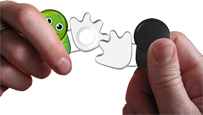Oct 21st, 2008
RFID and Mobililty
File under: technologies you’ve heard about, but aren’t sure what the possibilities are.
Radio Frequency Identifier (RFID) has been around since the 60s. If you work at a large office building you probably have an RFID key card with you all the time. If you commute through a toll booth you might have an RFID transponder on your dashboard that broadcasts a radio signal to the receiver at the toll booth. And you know that piece of metal you have to cut out of your Gap clothing or peel off your DVD purchase? That’s an RFID transponder that sends a one-way signal to an in-store security system, saying “hey, I’m here and I’m active.”
The RFID system is made up of a receiver and a transponder. A transponder is a portable thing that, when hit by a radio wave sends back an ID; usually a number. Over the past decade the price of transponders has gone down and the technology has greatly improved. Transponders are now able to store more data and transfer it to other transponders, opening up new possibilities for innovative products.
So, what? Well, here comes Poken.
These advances have led to a few interesting recent developments. Let’s start with Poken, a product of an angel-funded project, in Lausanne Switzerland.
Poken
Poken is an RFID transponder you carry with you. When you interact with other Poken carriers the device stores information that you later connect to your online social networks.
To activate your Poken you separate the “hand” from the “body” of the Poken and connect it to the USB port in your desktop computer. A web browser opens to the Poken web site where you register and input the social networks you wish to connect to. You are then ready to use your poken in real life social situations.
When you meet a person with a Poken you ‘high five’ with their Poken hand and they exchange IDs. Each ID is linked to a user’s public profile from a set of user-defined social networks. Users can manage privacy levels at the point of exchange by double clicking on their Poken. The next time you connect your Poken to a computer the IDs are uploaded and the public social network profiles are displayed. Each profile links to the social network’s full profile link letting you connect with people you’ve met or interacted with in person.
This product brings together natural physical interactions to the social networking world. Handshakes are a formal way of acknowledging meeting a person in many cultures. In many cases you are exchanging your ID, or name. You then log into social networks and add the person to your network of friends.
The natural evolution of Poken is to simplify it by removing a couple of the steps that make it socially awkward or that require the user to plug something in. If the RFID were embedded in a data-connected device you already have on your person, you could conceivably let the devices exchange information more passively, without an awkward high five of a plastic hand. Also, an already-connected device would let you push the data to the social networking site(s) over the air without the need to go through a USB port to a browser.
Web favorites
- Casino Sites Not On Gamstop
- Gambling Sites Not On Gamstop
- Betting Sites UK
- Casino Not On Gamstop
- Casinos Not On Gamstop
- Best Online Casino Canada
- Non Gamstop Casino Sites UK
- Sites Not On Gamstop
- Non Gamstop Casinos UK
- Non Gamstop Casinos
- Slots Not On Gamstop
- Best Non Gamstop Casinos
- UK Casino Not On Gamstop
- Gambling Sites Not On Gamstop
- Slots Not On Gamstop
- Non Gamstop Casinos UK
- Meilleur Casino En Ligne France
- Beste Online Casino Nederland
- Best Non Gamstop Casinos
- Non Gamstop Casino
- Betting Sites UK
- Casino Non Aams Italia
- Casino Online Non Aams
- UK Casino Not On Gamstop
- Casino Online
- Casino En Ligne Belgique
- Meilleur Site De Casino En Ligne Belgique
- Siti Scommesse Non Aams
- 파워볼사이트
- плинко
2 Responses to “RFID and Mobililty”
Leave a Reply
You must be logged in to post a comment.


Very cool article, and a great summary of what RFID is and does. Re: Poken, I agree about ideally removing some steps - the ‘awkward plastic hand hi-five’ sounds like it would be offputting to some, and with so many other wireless interactions around, USB seems too wirebound, though it is at least a ubiquitous interface.
I think near field communications (proximity-based interactions) is still an untapped area in mobile. Remember when you could beam your contact info from one Palm to another using infra-red?